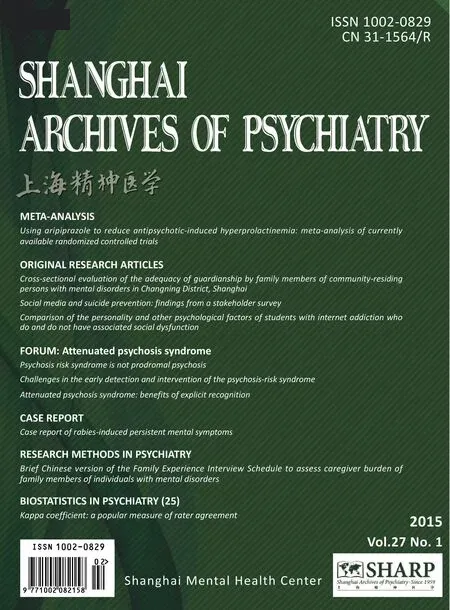Psychosis risk syndrome is not prodromal psychosis
2015-12-09LihuaXUTianhongZHANGJijunWANG
Lihua XU, Tianhong ZHANG, Jijun WANG*
•Forum•Attenuated psychosis syndrome
Psychosis risk syndrome is not prodromal psychosis
Lihua XU, Tianhong ZHANG, Jijun WANG*
psychosis risk syndrome; attenuated psychosis syndrome; schizophrenia spectrum disorder
1. Patient population
A variety of operational criteria have been suggested for the ‘psychosis risk syndrome’ (PRS), a condition that has been re-labelled as ‘attenuated psychosis syndrome’ in DSM-5. One common element of the various criteria is that the individual seeks treatment to relieve the distress and anguish that often accompanies the occurrence of psychotic-like experiences.[1]A study in China reported a prevalence of PRS of 4.2%among individuals who sought help at a psychological counseling center.[2]But - unlike persons with psychotic spectrum disorders—these individuals usually had fairly good insight and could differentiate real experiences from delusions or illusions, so they voluntarily sought help to understand their new, often frightening,experiences. In fact, only a small portion of individuals with psychotic-like experiences subsequently develop full-criteria psychotic disorders.[3]Unlike these individuals with PRS, persons with schizophrenia spectrum disorders usually lack insight and, thus, are unwilling to voluntarily seek treatment, especially during the early stages of the disorders. Based on these considerations,we contend that the PRS population seen in clinical settings is not the same as the ‘prodromal schizophrenia spectrum’ population, though individuals with PRS who have associated negative symptoms, impaired cognitive functioning, and non-psychotic symptoms are at a higher risk of developing schizophrenia than healthy controls.[4]
2. Diagnosis of psychosis risk syndrome
Currently, PRS is considered a transitional state useful for research purposes, not a clinical diagnosis. One of the most commonly used assessment tools for PRS, the Structured Interview for Prodromal Symptoms (SIPS)developed by McGlashan and colleagues,[5]identifies three PRS subtypes: attenuated positive symptoms syndrome, brief intermittent psychotic syndrome, and genetic risk and deterioration syndrome. Most research using the SIPS focuses on the developmental trajectory of the syndrome without strati fication of results by PRS subtype. Individuals with PRS either develop full-blown psychotic disorders or remit, with virtually all transitions occurring within 10 years of the onset of the PRS.[4]Some individuals who previously met the operational criteria for PRS may have persistent residual symptoms(i.e., they don’t fully remit), but the PRS label is no longer appropriate because they no longer meet PRS criteria. Thus, PRS is a transitional state, it should not be misconstrued as a disorder.
3. Outcome of psychosis risk syndrome
The main purpose of the development of the PRS label was to allow for the earlier identification of persons with psychotic conditions, that is, prodromal psychosis.If psychosis is the result of a progressive deterioration in brain function, early intervention may provide opportunities to prevent or ameliorate the condition,so any operational criteria that identify prodromal cases would be useful. However, several long-term studies report that two-thirds of the individuals who meet criteria for PRS never develop a psychotic disorder.Fusar-Poli and colleagues[6]found that the risk of transition from PRS to psychotic disorders was 18% in 6 months, 22% in 12 months, 29% in 2 years, and 32% in 3 years. This is consistent with long-term follow-up studies which report that most PRS-to-psychosis transitions occur within 2 years of the onset of PRS.[4,7]Thus individuals with PRS are at higher risk of developing psychosis than persons without PRS, but only a minority of them progress to a psychotic disorder. So PRS should not be mislabeled or misconstrued as ‘prodromal psychosis’.
Another problem in considering PRS as a type of prodromal psychosis is that PRS may not be a predictor of deterioration in functioning—a primary component of the current de finition of psychotic disorders. A study by Yung and colleagues[8]found that some individuals who transitioned from PRS to psychotic disorders retained high levels of functioning while other individuals with PRS who did not transition to psychotic disorders had serious impairments in functioning.[8]We conclude that PRS is not a sensitive predictor of psychotic disorders.
4. Intervention for psychosis risk syndrome
Due to the rather low conversion rate, the recommended clinical interventions for PRS and schizophrenia spectrum disorders are fundamentally different.Antipsychotics are the mainstream clinical intervention for schizophrenia spectrum disorders. In contrast, the clinical guidelines of the British National Institute for Health and Clinical Excellence (the NICE guidelines)[9]explicitly state that antipsychotics shouldnotbe used for either treatment or prevention among children or adolescents with PRS who do not meet the diagnostic criteria for psychotic disorders or schizophrenia. A metaanalysis on this issue by Van der Gagg and colleagues[10]recommends not using antipsychotics as first-line clinical intervention for individuals with PRS.
The recommended interventions for PRS are active monitoring and non-pharmaceutical psychotherapeutic behavioral interventions. The former intervention aims to reduce the duration of untreated psychosis (DUP)by rapidly identifying individuals who transition from PRS to a full psychosis. The latter intervention aims to prevent the transition to psychosis via integrated cognitive behavioral therapy, group therapy, or family therapy. The outcomes of these specialized types of therapy are usually superior to those of supportive psychological counseling.[11]
In summary, we think the current level of evidence is not sufficient to consider PRS a subtype of schizophrenia spectrum disorders. Moreover, individuals with PRS should not be treated using the same clinical protocols as those employed for schizophrenia spectrum disorders.
Conflict of interest
Authors declare no conflict of interest related to this article.
Funding
The preparation of this forum was supported by National Natural Science Foundation of China (81201043,81171267, 61102020, 81261120410, 81361120403),Shanghai Municipal Natural Science Foundation(12ZR1448400), National Key Clinical Disciplines at Shanghai Mental Health Center (Office of Medical Affairs,Ministry of Health, 2011-873; OMA-MH, 2011-873).
1. Solis M. Prevention: Before the break.Nature. 2014;508(7494): S12-13. doi: http://dx.doi.org/10.1038/508S12a
2. Zhang T, Li H, Woodberry KA, Seidman LJ, Zheng L, Li H, et al. Prodromal psychosis detection in a counseling center population in China: An epidemiological and clinical study.Schizophr Res. 2014; 152(2-3): 391-399. Epub 2013 Dec 30.doi: http://dx.doi.org/10.1016/j.schres.2013.11.039.
3. Nelson B, Yung AR. Psychotic-like experiences as over determined phenomena: when do they increase risk for psychotic disorder?Schizophr Res. 2009; 108(1-3): 303-304.doi: http://dx.doi.org/10.1016/j.schres.2008.10.006
4. Nelson B, Yuen HP, Wood SJ, Lin A, Spiliotacopoulos D,Bruxner A, et al. Long-term Follow-up of a Group at Ultra High Risk (“Prodromal”) for Psychosis: The PACE 400 Study.JAMA Psychiatry. 2013; 70(8): 793-802. doi: http://dx.doi.org/10.1001/jamapsychiatry.2013.1270
5. Miller TJ, McGlashan TH, Rosen JL, Cadenhead K, Cannon T, Ventura J, et al. Prodromal assessment with the structured interview for prodromal syndromes and the scale or prodromal symptoms: predictive validity, interrater reliability, and training to reliability.Schizophr Bull.2003; 29(4): 703-715. doi: http://dx.doi.org/10.1093/oxfordjournals.schbul.a007040
6. Fusar-Poli P, Bonoldi I, Yung AR, Borgwardt S, Kempton MJ,Valmaggia L, et al. Predicting psychosis: meta- analysis of transition outcomes in individuals at high clinical risk.Arch Gen Psychiatry. 2012; 69(3): 220-229. doi: http://dx.doi.org/10.1001/archgenpsychiatry.2011.1472
7. Yung AR, Nelson B, Stanford C, Simmons MB, Cosgrave EM,Killackey E, et al. Validation of “prodromal” criteria to detect individuals at Ultra High Risk of psychosis: 2 year followup.Schizophr Res. 2008; 105(1-3): 10-17. doi: http://dx.doi.org/10.1016/j.schres.2008.07.012
8. Yung AR, Nelson B, Thompson A, Wood SJ. The psychosis threshold in ultra high risk (prodromal) research: is it valid?Schizophr Res. 2010; 120(1-3): 1-6. doi: http://dx.doi.org/10.1016/j.schres.2010.03.014
9. National Institute for Health and Clinical Excellence.Psychosis and schizophrenia in children and young people Recognition and management (NICE clinical guideline 155).2013
10. van der Gaag M, Smith F, Bechdolf A, French P, Linszen DH, Yung AR, et al. Preventing a first episode of psychosis:Meta-analysis of randomized controlled prevention trials of 12 month and longer-term follow-ups.Schizophr Res.2013; 149(1-3): 56-62. Epub 2013 Jul 18. doi: http://dx.doi.org/10.1016/j.schres.2013.07.004
11. Bechdolf A, Wagner M, Ruhrmann S, Harrigan S, Putzfeld V, Pukrop R, et al. Preventing progression to first-episode psychosis in early initial prodromal states.BJP. 2012; 200(1):22-29. doi: http://dx.doi.org/10.1192/bjp.bp.109.066357
, 2014-12-02; accepted, 2015-01-09)

Lihua Xu graduated from Changsha Medical College in 2003 and obtained her Master’s degree in Medical Psychology from Suzhou University. She is currently a PhD candidate and an attending psychiatrist at Shanghai Mental Health Center, Shanghai Jiao Tong University School of Medicine.Her main research interest is early intervention of psychotic disorders.
精神病风险综合征并非精神病前驱期
徐丽华,张天宏,王继军
精神病风险综合征;轻微精神病综合征;精神分裂症谱系障碍
Summary:One of the most exciting trends in schizophrenia research is the shift in focus from treatment studies to studies about the early identification and prevention of schizophrenia. These studies have primarily focused on adolescents or young adults with prodromal symptoms or on clinically high-risk individuals who show similar impairments in cognitive and social functioning to those seen in individuals with schizophrenia and, thus, are considered at high risk of developing schizophrenia or other psychotic disorders. Some researchers have labeled this condition as psychosis risk syndrome (PRS). There are moves in some circles to re-define the condition as a disorder in its own right: the American Psychiatric Association’s Diagnostic and Statistical Manual of Mental Disorders 5thedition (DSM-5), lists ‘attenuated psychosis syndrome’ (APS) in the appendix as a condition for further study. Individuals with PRS are certainly at higher risk of developing a psychotic disorder than those without PRS, but the majority of those with PRS do not subsequently develop a psychotic disorder, so we argue against the inclusion of PRS or APS as a subtype of schizophrenia spectrum disorder.
[Shanghai Arch Psychiatry. 2015; 27(1): 42-44.
10.11919/j.issn.1002-0829.214178]
Shanghai Mental Health Center, Shanghai Jiao Tong University School of Medicine, Shanghai, China
* correspondence: jijunwang27@163.com
概述:精神分裂症研究中最令人振奋的趋势之一是从治疗学研究转向精神分裂症的早期识别和早期干预研究。后者的研究对象主要集中于处于精神病“前驱期”或“临床高危”的青少年或年轻的成年患者,他们出现的认知功能障碍和社会功能障碍与精神分裂症患者相似,因而被认为具有精神分裂症或其他精神病性障碍的高患病风险。有学者将这种认知和社会功能障碍的表现称为精神病风险综合征(psychosis risk syndrome, PRS)。在某些范围内已有试图将这一状态重新定义为一种精神障碍的举动,如:美国精神医学学会的《精神障碍诊断与统计手册》第五版(DSM-5)将“轻微精神病综合征”(attenuated psychosis syndrome,APS)列入“需要进一步研究的状态”。存在PRS的个体出现精神病性障碍的风险的确比没有PRS的人要高,但多数PRS个体以后也不会患精神病性障碍,因此,我们反对将PRS或APS作为一种亚型列入精神分裂症谱系障碍中。
本文全文中文版从2015年03月25日起在www.shanghaiarchivesofpsychiatry.org/cn可供免费阅览下载
猜你喜欢
杂志排行
上海精神医学的其它文章
- Kappa coefficient: a popular measure of rater agreement
- Brief Chinese version of the Family Experience Interview Schedule to assess caregiver burden of family members of individuals with mental disorders
- Case report of rabies-induced persistent mental symptoms
- Attenuated psychosis syndrome: bene fits of explicit recognition
- Comparison of the personality and other psychological factors of students with internet addiction who do and do not have associated social dysfunction
- Social media and suicide prevention: findings from a stakeholder survey
